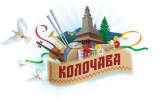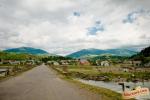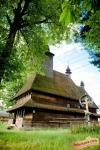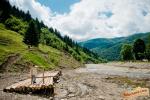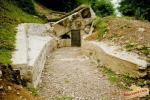Kolochava
The village of Kolochava (Czech: Koločava, Hungarian: Alsókalocsa) is an interesting tourist destination in several aspects. It is located in a valley surrounded by mountains offering beautiful vistas, clean air, river and mineral water, and is included in the Synevyr National Nature Park. Therefore the village of Kolochava is a lovely nature nook. Since ancient times, people have admired these places and many different cultures were mixed in the village. When this land bordered different states, the locals said that their sheep grazed in Poland, houses stood in Romania and they washed clothes in Czechoslovakia.
Here is the village chronology under different rules:
9thcentury Slavic principality of White Croats
11thcentury-1867 Kingdom of Hungary
1867-1918 Austria-Hungary
1919 Hungarian Soviet Republic
1919-1939 Czechoslovakia
1939 Carpatho-Ukraine
1939-1944 Hungary
1944-1945 Transcarpathian Ukraine
1945-1991 Ukrainian Soviet Socialist Republic
Since 1991 Ukraine
The rich historical background helps Kolochava to develop tourism rapidly. At present there are ten museums: Old Village (Stare Selo) Skansen Museum of Folk Architecture and Rural Life, Kolochava Narrow Gauge Railway, Kolochava Bokorash, Soviet School and Czech School Museums, Arpada Line Military Museum, Internationalist Soldiers Memorial Museum, Museum of the Local Insurgents—Bunker of Mykhaylo Shtayer, wooden Church of the Holy Spirit—the late 18th century monument of Baroque architecture and John Olbrakht Museum. That’s an amazing achievement. Another attraction in the village is a large number of monuments amounting to twenty, as well as memorial stones and plaques.
More detailed information on several museums is given below.
The Old Village open-air Museum of Folk Architecture and Rural Life presents houses and buildings of different ages. They belonged to different layers of the population in terms of their wealth: the poor, middle class and the village chief as well as kinds of activities: shepherds, lumberjacks, millers and shoemakers.
You can penetrate the spirit of the Old Village owing to:
• Parochial School represents the atmosphere of children’s education in the mid-19th century and mid-20th century. At that time school children learnt to read church books. Students of all ages studied in one classroom and a teacher deacon could punish their disobedience with the rod.
• Poor Farmer’s Hut displays difficult living conditions in the late 19th-early 20th centuries. A numerous family lived in a small room without floor, with one bed, small windows and no light. The house was built in 1856 and was transported to the museum in its original form.
• Everyone could drink horilka (vodka) and eat in the Jewish “Wolf’s Tavern”. The well-arranged room of a Jew shows that it belonged to the richest segment of the rural population. He rented out a living room to his visiting guests. Jewish men visited the Jewish house of prayer (buzhnia) every Saturday.
• Steam House was a village bathhouse popular with the representatives of Kolochava intelligentsia under Austro-Hungarian rule. During the period of the Czechoslovak Republic the ordinary villagers had the opportunity to go to such steam houses as well.
• Shepherd had no time to maintain his dwelling properly as he tended his flock of sheep in the meadow. However there is everything required for milk processing in the Shepherd’s Hut. There is Trembita fastened under the roof that is still very popular with shepherds. Shepherd’s Summer Cottage called Salash (kolyba, wooden hut) is located nearby. It stood on the meadow and the shepherd lived in it most of the year.
• Shoemaker’s (Schuster’s) House presents an interesting collection of leather shoes made for the villagers one hundred years ago. Shoemaker also made cheresy— belts for men. This type of belt helped to support the back during heavy physical work, and included pockets for a knife and tobacco. It also indicated the social status of a man.
• The (Cobbler’s) House contains a collection of different sewing machines and scissors of various types and sizes. This building once belonged to Kolochava shoemaker Mytro Dats who made shoes for everyone in the village.
• Gendarmerie operated in the village under each rule. The Skansen displays a Hungarian Gendarmerie Station. Several policemen, the representatives of the ruling authorities, stayed there and kept order in the village. All perpetrators were immediately thrown into prison located directly under the gendarmerie.
• Forge was a blacksmith’s workplace and no village could do without it. This smithy can work even now.
• The assortment of carpenter’s products was very broad and a large number of tools were used for their production. All those tools are displayed in the Carpenter’s House and Workshop. The most interesting is a hundred-year-old woodworking machine that works so far.
• Weaving was one of the most popular type of economic activities and has centuries of history. All village women and girls weaved home made fabric. You can learn how to weave fabric on the same weaving loom at the Weaver’s House.
• Byriv (the Village Headman) was the first person of the village. Therefore his house differed significantly from the others. Its interior is spacious and light as it was made of large logs. There is floor inside and the furnishings are much richer.
Arpada Line
Arpada Line is a defensive line created by the Hungarian troops in the Eastern Carpathians in the 1940s against the advancing Red Army, stretching almost 600 kilometers. It was not a solid line but consisted of defensive units in different directions. The Historical Military Museum in Kolochava displays four bunkers out of nearly 30 iron-concrete bunkers. Here you can see a collection of World War II military equipment and visit real bunkers where there are displayed over 2,000 authentic items.
There are the following restored four bunkers: Command Bunker, Defensive Bunker, Hospital Bunker and Kitchen Bunker. In this museum you will learn about the Second World War in Transcarpathian Region. The bunkers in their original arrangement together with the original weapons and equipment are good auditoriums for history lessons. The Arpada Line Museum includes the restored one-hundred-meter long defensive line that is the longest in Europe.
Church of the Holy Spirit
The slender wooden church was built without a single nail in 1795. The beautiful church delights people more than a century. Now the church functions only as a museum. The interior embellishments of the church were not spared. In Soviet times, the communists removed all icons from the church and put portraits of their leaders instead where used to be the altar, thus converting the church into an atheism museum. However, due to that fact the beautiful church was spared from total destruction.
You will be amazed at the diverse tourism products offered in Kolochava, especially Sheep Husbandry School. It is located on 1,719-meter-high Mount Strymba. There you can learn from the seasoned shepherds how to graze a flock of sheep and make Bryndza (sheep milk cheese). Before visiting the Arpada Line Museum you can ride a BRDM (Combat Reconnaissance/Patrol Vehicle) as well as arrange a picnic lunch in the forest prepared in a real army field kitchen.
The information was taken from the http://kolochava.com/ website.


